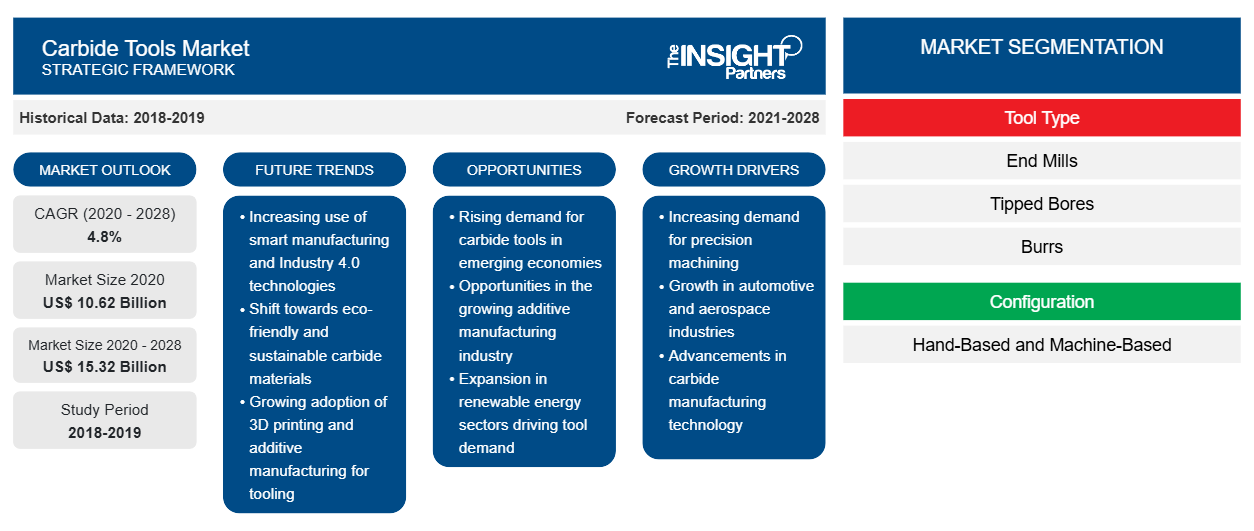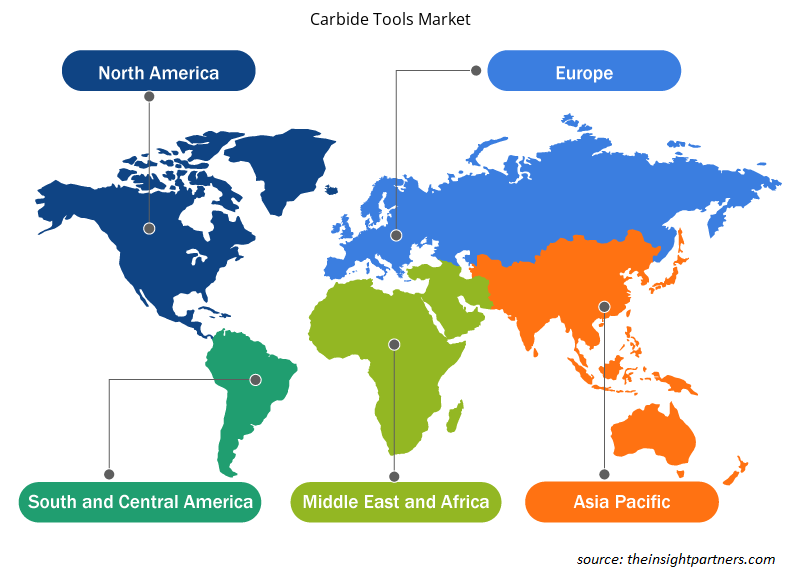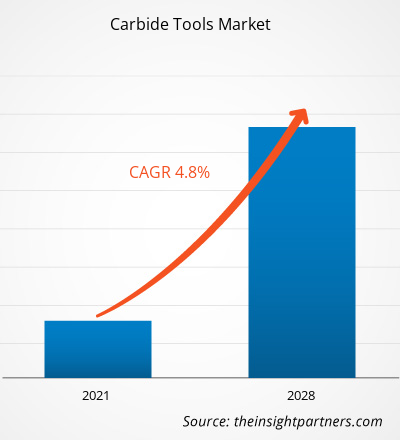[Research Report] The carbide tools market was valued at US$ 10,623.97 million in 2020 and is projected to reach US$ 15,320.99 million by 2028; it is expected to grow at a CAGR of 4.8% from 2021 to 2028.
Rising developments in manufacturing designing and growing requirements to increase the production efficacy are establishing the base for the manufacturer’s investigation of superior machine tool products, thereby boosting the demand for carbide tools. The machine tools used across industries are primarily utilized for machining or shaping metal or other rigid materials to offer a unique form with the help of boring, grinding, shearing, and cutting. Presently, there are two main types of machine tools significantly being used across different industries – high-speed steel (HSS) and carbide tools. These tools are extensively used across machining applications due to their significant features such as high speed, reduced cycle time, long working life, retaining cutting edge at high machining temperature, and exceptional wear resistance at cutting edge. The rising popularity of carbide tools, particularly across manufacturing applications, is one of the significant factors expected to boost the market during the forecast period. Furthermore, these carbide tools are being used in manufacturing units across automotive, aerospace, railway, furniture & carpentry, energy & power, and healthcare equipment industries. In these industries, special cutting tools are used to design and manufacture a product, which is propelling the demand for carbide tools. The deployment of carbide tools across different industries to operate it manually or automatically is further boosting the growth of the carbide tools market globally.
Customize This Report To Suit Your Requirement
You will get customization on any report - free of charge - including parts of this report, or country-level analysis, Excel Data pack, as well as avail great offers and discounts for start-ups & universities
Carbide Tools Market: Strategic Insights

- Get Top Key Market Trends of this report.This FREE sample will include data analysis, ranging from market trends to estimates and forecasts.
You will get customization on any report - free of charge - including parts of this report, or country-level analysis, Excel Data pack, as well as avail great offers and discounts for start-ups & universities
Carbide Tools Market: Strategic Insights

- Get Top Key Market Trends of this report.This FREE sample will include data analysis, ranging from market trends to estimates and forecasts.
Impact of COVID-19 Pandemic on Carbide Tools Market
The COVID-19 pandemic has shaken several industries. The tremendous growth in the spread of the virus has urged governments worldwide to impose strict restrictions on vehicles’ and human’s movement. Due to travel bans, mass lockdowns, and business shutdowns, the pandemic has adversely affected economies and countless industries in various countries. The lockdown imposition has resulted in lesser production of commodities, goods, and services. Therefore, manufacturing, automotive, semiconductor & electronics, oil & gas, mining, aviation, and other industries have witnessed a decline in their operations due to the temporary shutdown of activities.
The worldwide lockdown to minimize the transmission of virus has significantly disrupted the supply chain activities along with production volume across several manufacturers, especially the small & medium enterprise owners. Moreover, the production activities in multiple industries have contracted significantly during 2020, resulting in decline in the carbide tools market. However, with the increasing need for healthcare products, the demand for carbide tools is surging from the medical industries.
Carbide Tools Market Insights
Increased Production in Automotive Sector Fuels Growth of Carbide Tools Market
Automotive production is constantly rising across the world, particularly in Asian and European countries, which is driving the demand for carbide tools. The sector widely uses carbide tools in crankshaft metal machining, face milling, and hole-making, among other machining operations involved in auto parts manufacturing. The automotive industry is obtaining excellent results with the use of tungsten carbide in ball joints, brakes, crank shafts in performance vehicles, and other mechanical parts of a vehicle that sees hard usage and extreme temperatures. Automotive giants such as Audi, BMW, Ford Motor Company, and Range Rover are contributing significantly to the carbide tools market growth. Hybrid electric vehicles are gaining traction in North America, thus boosting the carbide tools market growth in the region. Countries such as the US and Canada are prominent automotive manufacturers in the region. According to the American Automotive Policy Council, automakers and their suppliers contribute ~3% to the US GDP. General Motors Company, Ford Motor Company, Fiat Chrysler Automobiles, and Daimler are among the major automotive manufacturers in North America. As per data by the International Organization of Motor Vehicle Manufacturers, in 2019, the US and Canada manufactured ~2,512,780 and ~461,370 cars, respectively. Further, the carbide tools are also highly used in railway, aerospace & defense, and marine industries.
Tool Type - Based Market Insights
Based on tool type, the carbide tools market is segmented into end mills, tipped bores, burrs, drills, cutters, and other tools. In 2020, the end mills segment accounted for the largest share in the market.
Configuration-Based Market Insights
Based on configuration, the carbide tools market is bifurcated into hand-based and machine-based. In 2020, the machine-based segment accounted for a larger market share.
End-User-Based Market Insights
By end-user, the carbide tools market is segmented into automotive and transportation, metal fabrication, construction, oil and gas, heavy machinery, and other end-users. In 2020, the automotive and transportation segment accounted for the largest share in the market.
The players operating in the carbide tools market adopt strategies such as mergers, acquisitions, and market initiatives to maintain their positions in the market. A few developments by key players are listed below:
- In November 2020, GARR TOOL entered a partnership with Mastercam to offer complete tool library to customers natively inside the Mastercam platform. The partnership will be of tremendous value for current and future customers as the manufacturing process becomes more and more reliant on instant and easy access to data.
- In February 2019, CERATIZIT Group acquired 50% of the shares in Stadler Metalle GmbH & Co. KG. The company stated that the investment in Stadler enabled them to secure the entire raw materials supply chain and focus even more strongly on recycling carbide tools in the supply of raw materials.
Carbide Tools Market Regional Insights
The regional trends and factors influencing the Carbide Tools Market throughout the forecast period have been thoroughly explained by the analysts at The Insight Partners. This section also discusses Carbide Tools Market segments and geography across North America, Europe, Asia Pacific, Middle East and Africa, and South and Central America.

- Get the Regional Specific Data for Carbide Tools Market
Carbide Tools Market Report Scope
| Report Attribute | Details |
|---|---|
| Market size in 2020 | US$ 10.62 Billion |
| Market Size by 2028 | US$ 15.32 Billion |
| Global CAGR (2020 - 2028) | 4.8% |
| Historical Data | 2018-2019 |
| Forecast period | 2021-2028 |
| Segments Covered |
By Tool Type
|
| Regions and Countries Covered | North America
|
| Market leaders and key company profiles |
Carbide Tools Market Players Density: Understanding Its Impact on Business Dynamics
The Carbide Tools Market is growing rapidly, driven by increasing end-user demand due to factors such as evolving consumer preferences, technological advancements, and greater awareness of the product's benefits. As demand rises, businesses are expanding their offerings, innovating to meet consumer needs, and capitalizing on emerging trends, which further fuels market growth.
Market players density refers to the distribution of firms or companies operating within a particular market or industry. It indicates how many competitors (market players) are present in a given market space relative to its size or total market value.
Major Companies operating in the Carbide Tools Market are:
- Mitsubishi Materials Corporation
- Sandvik Coromant
- KYOCERA Precision Tools
- Ingersoll Cutting Tool Company
- CERATIZIT S.A.
Disclaimer: The companies listed above are not ranked in any particular order.

- Get the Carbide Tools Market top key players overview
The global carbide tools market has been segmented as mentioned below:
By Tool Type
- End Mills
- Tipped Bores
- Burrs
- Drills
- Cutters
- Other Tools
By Configuration
By End-User
- Automotive and Transportation
- Metal Fabrication
- Construction
- Oil and Gas
- Heavy Machinery
- Other End-users
By Geography
- North America
- US
- Canada
- Mexico
- Europe
- France
- Germany
- Italy
- UK
- Russia
- Rest of Europe
- Asia Pacific (APAC)
- China
- India
- South Korea
- Japan
- Australia
- Rest of APAC
- Middle East & Africa (MEA)
- South Africa
- Saudi Arabia
- UAE
- Rest of MEA
- South America (SAM)
- Brazil
- Argentina
- Rest of SAM
Company Profiles
- Xinrui Industry Co., Ltd.
- CERATIZIT S.A.
- GARR TOOL
- Ingersoll Cutting Tool Company
- KYOCERA Precision Tools
- DIMAR GROUP
- MITSUBISHI MATERIALS Corporation
- Sandvik Coromant
- YG-1 Co., Ltd.
- Makita Corporation
Frequently Asked Questions
Which tool type is expected to dominate the market in the forecast period?
The carbide tools market is led by end mills segment with highest share and is expected to dominate in the forecast period. The carbide end mills are heat resistant and are used in high-speed applications to cut the hardest materials, such as cast iron, alloys, plastics, and non-ferrous metals. End mills cut rotationally in a horizontal and lateral (side to side) direction. Moreover, carbide end mills are used to cut machine parts, wood engravings, jewelry designs, and plastic cutting, among others. The end mills usually perform operations including profiling, slotting, contouring, reaming, and counter boring.
What are market opportunities for carbide tools?
The carbide cutting tools form an essential part of industrial tools. These tools are used in metal cutting tools for several materials on heavy duty machines such as CNC (computer numerical control) lathes, engines lathes, and turret lathes. Carbide cutting tools are extensively used in machining applications owing to their features such as high-speed operations; high temperature withstanding ability, allowing the retention of the cutting edge; exceptional wear resistance, especially at the cutting edge; and ability to reduce cycle time along with ensuring prolonged working life is anticipated to offer ample growth opportunities for the global carbide tools market players.
What are reasons behind carbide tools market growth?
Automotive production is constantly rising across the world, particularly in Asian and European countries, which is driving the demand for carbide tools. The sector widely uses carbide tools in crankshaft metal machining, face milling, and hole-making, among other machining operations involved in auto parts manufacturing. The automotive industry is obtaining excellent results with the use of tungsten carbide in ball joints, brakes, crank shafts in performance vehicles, and other mechanical parts of a vehicle that sees hard usage and extreme temperatures. Automotive giants such as Audi, BMW, Ford Motor Company, and Range Rover are contributing significantly to the carbide tools market growth.
- Historical Analysis (2 Years), Base Year, Forecast (7 Years) with CAGR
- PEST and SWOT Analysis
- Market Size Value / Volume - Global, Regional, Country
- Industry and Competitive Landscape
- Excel Dataset
Testimonials
Reason to Buy
- Informed Decision-Making
- Understanding Market Dynamics
- Competitive Analysis
- Identifying Emerging Markets
- Customer Insights
- Market Forecasts
- Risk Mitigation
- Boosting Operational Efficiency
- Strategic Planning
- Investment Justification
- Tracking Industry Innovations
- Aligning with Regulatory Trends
Yes! We provide a free sample of the report, which includes Report Scope (Table of Contents), report structure, and selected insights to help you assess the value of the full report. Please click on the "Download Sample" button or contact us to receive your copy.
Absolutely — analyst assistance is part of the package. You can connect with our analyst post-purchase to clarify report insights, methodology or discuss how the findings apply to your business needs.
Once your order is successfully placed, you will receive a confirmation email along with your invoice.
• For published reports: You’ll receive access to the report within 4–6 working hours via a secured email sent to your email.
• For upcoming reports: Your order will be recorded as a pre-booking. Our team will share the estimated release date and keep you informed of any updates. As soon as the report is published, it will be delivered to your registered email.
We offer customization options to align the report with your specific objectives. Whether you need deeper insights into a particular region, industry segment, competitor analysis, or data cut, our research team can tailor the report accordingly. Please share your requirements with us, and we’ll be happy to provide a customized proposal or scope.
The report is available in either PDF format or as an Excel dataset, depending on the license you choose.
The PDF version provides the full analysis and visuals in a ready-to-read format. The Excel dataset includes all underlying data tables for easy manipulation and further analysis.
Please review the license options at checkout or contact us to confirm which formats are included with your purchase.
Our payment process is fully secure and PCI-DSS compliant.
We use trusted and encrypted payment gateways to ensure that all transactions are protected with industry-standard SSL encryption. Your payment details are never stored on our servers and are handled securely by certified third-party processors.
You can make your purchase with confidence, knowing your personal and financial information is safe with us.
Yes, we do offer special pricing for bulk purchases.
If you're interested in purchasing multiple reports, we’re happy to provide a customized bundle offer or volume-based discount tailored to your needs. Please contact our sales team with the list of reports you’re considering, and we’ll share a personalized quote.
Yes, absolutely.
Our team is available to help you make an informed decision. Whether you have questions about the report’s scope, methodology, customization options, or which license suits you best, we’re here to assist. Please reach out to us at sales@theinsightpartners.com, and one of our representatives will get in touch promptly.
Yes, a billing invoice will be automatically generated and sent to your registered email upon successful completion of your purchase.
If you need the invoice in a specific format or require additional details (such as company name, GST, or VAT information), feel free to contact us, and we’ll be happy to assist.
Yes, certainly.
If you encounter any difficulties accessing or receiving your report, our support team is ready to assist you. Simply reach out to us via email or live chat with your order information, and we’ll ensure the issue is resolved quickly so you can access your report without interruption.















The List of Companies - Carbide Tools Market
- Mitsubishi Materials Corporation
- Sandvik Coromant
- KYOCERA Precision Tools
- Ingersoll Cutting Tool Company
- CERATIZIT S.A.
- Xinrui Industry Co., Ltd.
- GARR TOOL
- DIMAR GROUP
- YG-1 Co., Ltd.
- Makita Corporation






 Get Free Sample For
Get Free Sample For